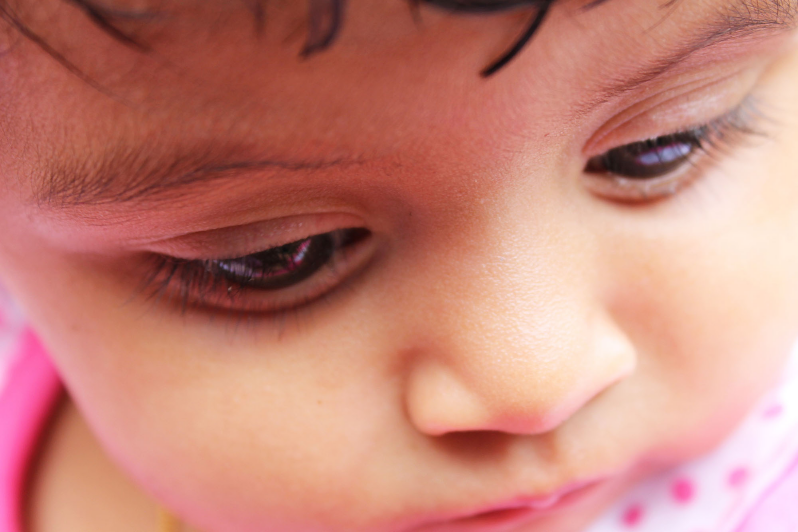
When it comes to your child’s skin, you can depend on one thing: It’s bound to erupt into rash or redness at some point during the first year. Why? The human skin acts as a protective barrier against all sorts of elements, from sun to bacteria, but it takes around a year or so for it to function effectively. It starts out thinner, has less pigment, and doesn’t help regulate body temperature as well as the skin of bigger kids and adults.
No baby escapes the most common skin issue: diaper rash. The diaper area is warm and moist, which breaks down the skin on that tender tush. Add irritating poop and pee and you’ve got the perfect environment for breakouts. Keep diaper rash under control by changing your baby often, using petroleum jelly or a barrier cream with zinc oxide to protect their skin (be sure to check out our article on diaper cream sticks), and letting their naked bottom air out occasionally (put a sheet on the floor and let them loose). Protect the rest of their fragile skin with mild products, such as hypoallergenic and fragrance-free soaps, washes and lotions. Once your baby turns 1, you can relax a little, as their skin will be thicker and far less prone to problems.
The answer to this question is, of course, that it depends on the condition. Many skin conditions in children are treatable by over-the-counter medications, but some do require prescriptions. It is important to know exactly what you are treating so the appropriate therapy can be started — after all, treating your child’s ailment incorrectly can actually make matters worse. This is why it is so important to have your child seen by MacKoul to correctly diagnose the skin condition before treating it.
There are also other health concerns that can cause recurring skin issues and highlight the importance of seeing your pediatrician. For example, people with diabetes are more prone to skin infections. You should be very aware of your child’s skin and make sure to get any skin problems evaluated promptly, especially if you have a history of such an illness in your family. Later in life, people with diabetes remain prone to skin infections and, because they can develop problems with sensation in their extremities, may have problems with ulcerations of their feet. It is important to do a good job controlling diabetes early on and make sure your child is followed closely by a pediatrician.
Yes! There are a number of skin problems that are triggered by allergies, such as poison ivy rashes which are very, very common in the spring and summer. Atopic dermatitis most commonly occurs in people who have allergies or asthma or a family history of allergies.
Children are indeed more likely to get bigger reactions to bug bites. Typically you may see much bigger bumps at the site of a bite on a child than one on an adult. Also, because children on average spend more time playing outdoors than do adults, they are more likely to be bitten.
Dry skin can have a number of causes. In the immediate newborn period, it is commonly seen in post-mature babies. It is important to distinguish dry skin from eczema, and severe cases of dry skin should be evaluated by your pediatrician. For mild dry skin, it is important to limit exposure to soaps (whose “hydrophobic” qualities will dry out the skin even more) and to frequently apply bland (non-scented) thick moisturizers such as
Vaseline, Eucerin, Vanicreme, or Aquaphilic.
For older children. an important thing to note is that, because of the soap contents, all bubble baths will dry out skin to a certain extent. If a child gets rashes after bubble baths they should, of course, avoid them. Instead, opt for some fun bath toys instead of the bubbles.
There are a couple of different diseases that sound somewhat similar and sometimes confuse people. One is psoriasis, which is a skin condition where one sees reddish/orange areas on the skin that have thick white scale. Psoriasis lesions are more frequent on the elbows, knees, and scalp. Psoriasis also frequently causes nail changes. Another skin condition that sounds very similar is xerosis. Xerosis is the medical term for dry skin.
Psoriasis is a hereditary condition and has a definite tendency to run in families. However, not everyone who develops psoriasis has someone else in his or her family with it. A minority of children with psoriasis actually develop the disease themselves. Likewise, just because you have it doesn’t mean that your child will, too.
Mild psoriasis can be treated with topical corticosteroids, topical Vitamin-D related compounds such as Dovonex and topical Vitamin-A related compounds such as Tazorac. Ultraviolet light is also quite effective for psoriasis, but it carries with it an increased risk for later skin cancers and photoaging just like tanning does. Severe cases of psoriasis that don’t respond to topical treatments or light therapy sometimes have to be treated with oral or injectable medications, although this is typically avoided as much as possible in children. Diet does not play a major role in the treatment of psoriasis.
Eczema looks the same in children and adults. It can actually vary quite widely in its appearance, from a red weepy crusty appearance to thickened dry skin with skin markings, depending on the underlying cause of the eczema and how long it has been present. Eczema can even be mimicked by other conditions such as fungal infections of the skin, bacterial infections of the skin, and even, on occasion, herpes simplex. This is why it is important that if a child has any sort of unusual rash that is worsening or doesn’t resolve in a few days, you need to be coming into MacKoul and getting an accurate diagnosis.
Any rash in a child who appears ill should be evaluated immediately by your pediatrician. Any rash that steadily is worsening and spreading should be evaluated as well. Parents should realize that it is possible to become allergic to, or irritated by, over-the-counter treatments — so seeing your pediatrician first is usually best. It is not a good idea to go from over-the-counter therapy to over-the-counter therapy without an idea of what you are treating.
For most people, 80% of their total lifetime sun exposure occurs during their childhood. To prevent skin cancer and to reduce photoaging, a parent can make the most impact by limiting sun exposure early on. It is also known that melanoma, a potentially fatal skin cancer, is associated with blistering sunburns during childhood. To avoid too much sun exposure, you should:
- limit your child’s outdoor activities in the middle part of the day between 10:00 and 2:00 when it is the hottest and brightest,
- use clothing and hats to help protect their skin from the sun’s harmful effects,
- and apply a sunscreen of SPF 15 or higher.
If your child is going to be sweating or swimming (or otherwise exposed to water), it is very important that the sunscreen be waterproof, and even waterproof sunscreens should be reapplied every two hours while your child is out in the sun.
Sunblocks block all form of light, and zinc oxide is a good example of a sunblock. It is a very effective way to prevent sun, although many people don’t like to wear plain zinc oxide. When one looks for a sunblock/sunscreen, make sure the SPF is 40 or higher and that it says broad-spectrum sun protection.
Here is a brief video from the Cincinnati Children’s Hospital that has some useful knowledge when it comes to your child’s skin:
And here is a visual guide to some common skin ailments, including pictures:
http://www.babycenter.comIf you have questions about a problem with your child’s skin or notice a persistent rash that isn’t going away, please don’t hesitate to call MacKoul at 239-573-2001 to set an appointment.
MacKoul Pediatrics is an amazing local pediatrics office in Cape Coral, FL where caring, compassionate doctors and nurses work with you to keep your children as healthy as possible. MacKoul cares for children from birth to college age, from Cape Coral, Fort Myers, Naples, and beyond.
August 3, 2015
 When it comes to your child’s skin, you can depend on one thing: It’s bound to erupt into rash or redness at some point during the first year. Why? The human skin acts as a protective barrier against all sorts of elements, from sun to bacteria, but it takes around a year or so for it to function effectively. It starts out thinner, has less pigment, and doesn’t help regulate body temperature as well as the skin of bigger kids and adults.
When it comes to your child’s skin, you can depend on one thing: It’s bound to erupt into rash or redness at some point during the first year. Why? The human skin acts as a protective barrier against all sorts of elements, from sun to bacteria, but it takes around a year or so for it to function effectively. It starts out thinner, has less pigment, and doesn’t help regulate body temperature as well as the skin of bigger kids and adults.